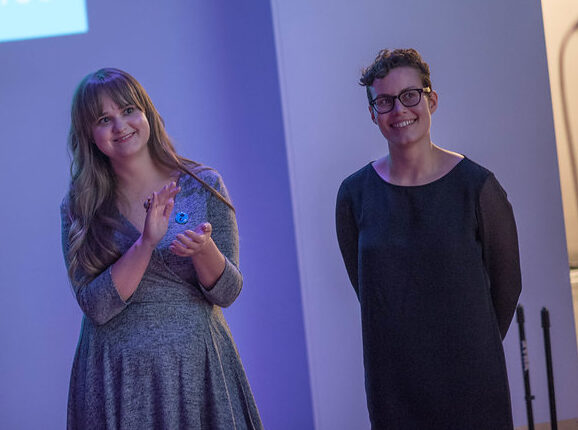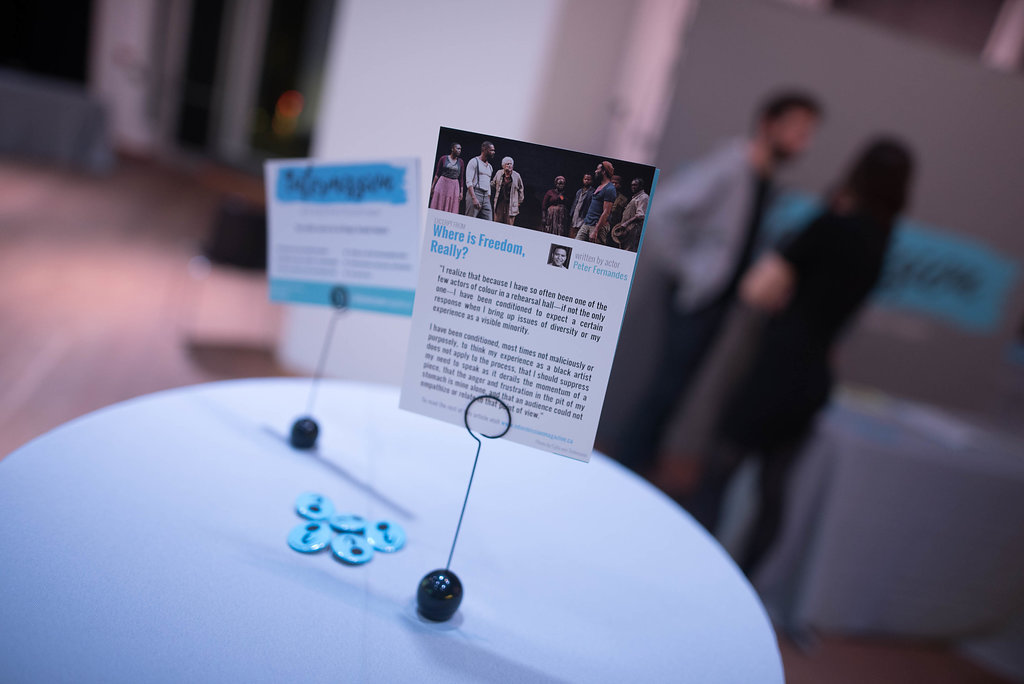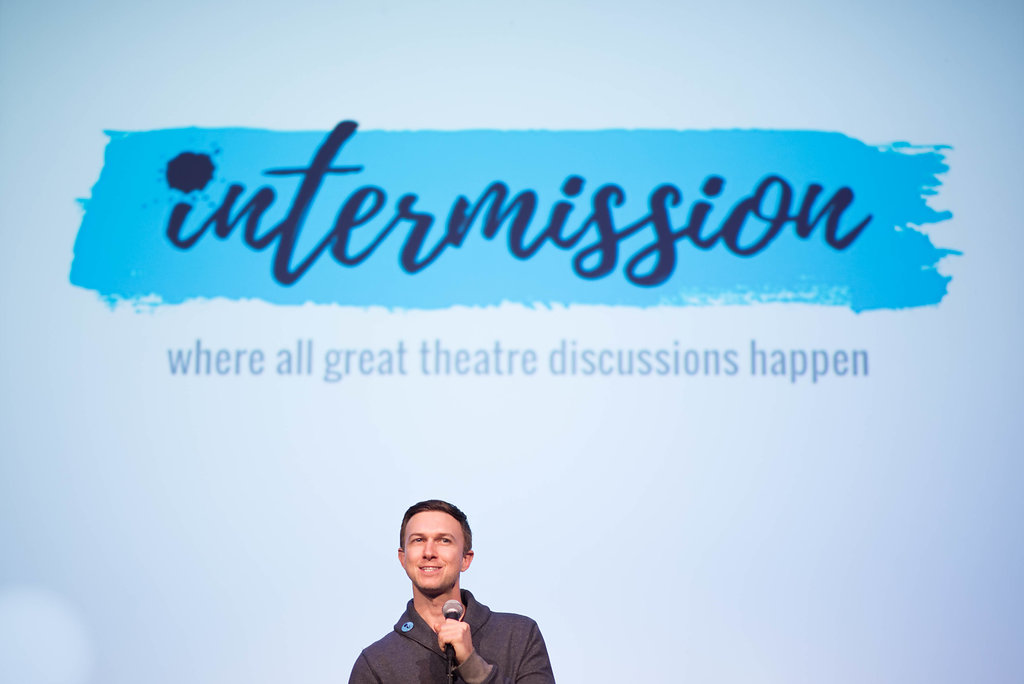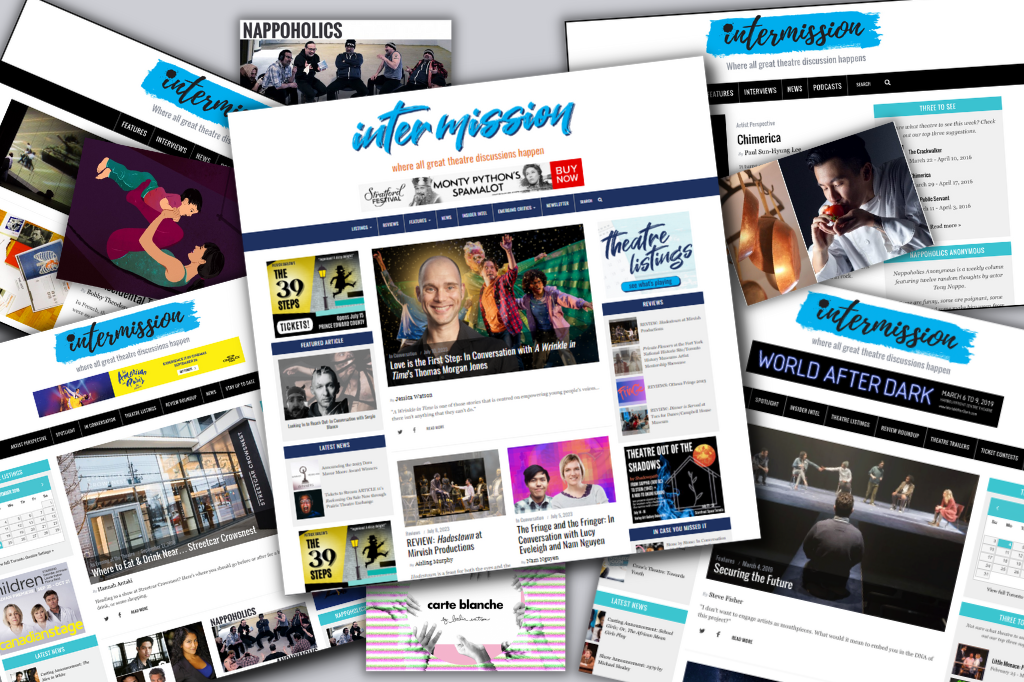Exeunt, Pursued by a Bear
Seven years. That’s how old this little online magazine is. That might not seem like much in the grand scheme of things but we sure have packed in a whole lot of life in that time.
This collection of pixels has housed hundreds, if not thousands of essays, reviews, and news pieces about Canadian theatre and theatre artists. This particular article you’re reading is slightly different from the others. I’m breaking the fourth wall to say my own personal goodbye. I’ve never had to say goodbye to a magazine before, but doing it in written form seemed appropriate.
By the time you read this, I will no longer be publisher of Intermission magazine. I know what many of you are thinking: “You were the publisher of Intermission?” Well yes, apparently I was. Intermission has been my side passion project from my main passion project, Company Theatre. (What can I say, apparently I like passion projects.) When I started this magazine I was lucky enough to collaborate with two amazing editors and, as we were launching, their roles were clear, they were co-editors-in-chief. But having no experience in the publishing world, I had zero idea what exactly my role was. So, I asked them what it should be and they looked at me, puzzled. It turns out the answer was obvious: I was the publisher.
Not to worry, my departure does not mean the end of Intermission. Far from it. I am leaving the magazine in the hands of an incredible group of women who I am positive will take it to ever-greater heights. More on this later. (This is what we in the media biz call a “tease.”)
First, I need to take this opportunity to acknowledge some of the people who helped create and build Intermission through its first seven years. At the top of the list of many, many people who I (and any of you who love Intermission) owe a huge debt of gratitude to are the aforementioned original editors, May Antaki and Maija Kappler. If you’re thinking of launching your own online magazine I recommend you find two editors as talented and passionate as May and Maija. Both were instrumental in the launch of the magazine in 2016 and in establishing an extremely high editorial standard in our first few years of existence.

In fact, they returned to edit this article for me as one last ride together into the digital magazine sunset. So if this article doesn’t adhere precisely to the 17th edition of the Chicago Manual of Style, you know who to blame. Apologies, the hardest thing about not being a publisher anymore is dropping the publisher lingo. (Editors’ note: Intermission left Chicago behind years ago — we remember, because we kept sending Phil screenshots of grammatical errors in articles that needed changing. Eventually we let the new editors take the style in a different direction, but we’re not sure what that is, so if this article isn’t grammatically in keeping with the rest of the magazine, we don’t know any better.)
The vision for Intermission hasn’t changed at all since it started. At that time, theatre content in mainstream media was clearly diminishing. It didn’t take a genius to recognize that this trend was only going to get worse. And worse it has gotten. In the seven years since we launched, the National Post and Toronto Sun stopped covering theatre, the Toronto Star’s coverage has diminished, and most recently NOW magazine was sold, essentially ending its contribution to theatre coverage. What still exists in mainstream media outlets is read by fewer and fewer people and I’m sure in time will disappear as well.
Theatre was bound to be a casualty in the titanic shift in the business of mainstream media. To be fair, we did have it really good for a long time. Theatre coverage used to be deemed newsworthy and so for years our industry took for granted that we could speak to audiences through these outlets free of charge. This was great for many reasons but did make us fairly complacent. Truthfully the quality of coverage in these outlets wasn’t always the most interesting, creative, or inspirational. The reviews were the reviews; the good ones helped sell tickets, the bad ones didn’t. But the other coverage—the preview articles, interviews, and features—often left a lot to be desired. Still, as long as there were platforms willing to write about us for free, it made sense to accept whatever coverage would come our way. But once that started to disappear, it felt like a great opportunity to take responsibility for those conversations and rethink how we talk about ourselves and our work to potential audience members. If theatre coverage doesn’t possess the elements that make great storytelling—creativity, truth, intelligence, playfulness, bravery—then why would anyone assume that the theatre it’s covering will?
This was the impulse behind our decision to have as much of our content be written by theatre artists themselves. As often is the case, trusting in the talent of Canadian theatre artists led to beautiful and extraordinary results. We’ve published hundreds of pieces from artists across the country over the years. Some of the early ones, by people like Christine Horne, Anusree Roy, Jesse LaVercombe, Mikaela Davies, Vanessa Smythe, Megan Robinson, Frances Koncan, Steffi DiDomenicantonio, Matthew Edison, and Rick Roberts, helped us establish Intermission as a different kind of theatre content.

In this time we also had a few artists who contributed regular columns. Bahia Watson wrote a gorgeous collection of articles called “carte blanche,” each one a piece of art in itself. And of course, I gotta thank my first and only star columnist, who put the “Nappo” in Nappoholics Anonymous. Tony was one of the first artists I approached about writing for Intermission. I knew whatever he came up with would at the very least not be boring. Nappoholics was much more than that — it was often thought-provoking, always relevant, and very funny. Tony wrote over two hundred columns and it truly became the anchor of our magazine for the first couple of years. It developed a loyal audience that seemed to connect the industry in a unique way. Surprisingly, it also attracted a fair number of readers who weren’t in theatre, solidifying my belief that it was through innovative content that we could inspire people to connect to the community.
I won’t be able to thank everyone who has thus far made a meaningful contribution to Intermission. The list is very long and May and Maija are sticklers for word count. (Editors’ note: This isn’t true. Intermission never had a word count limit but we tried to make each piece the exact length it needed to be and Phil tends to get wordy so we’re doing our best to rein him in.) But there are still a few more people I must acknowledge. Theatre artist and photographer extraordinaire Dahlia Katz was someone I didn’t know when I approached her about the possibility of doing some photography for the magazine. Not only did she generously agree to help, she became a key collaborator, creating breathtaking photos that became the foundation of our Spotlight series. And, of course, I also have to shout out Janice Peters Gibson, who has worked with me for thirteen years at Company Theatre. When she came back from maternity leave years ago, I very nonchalantly said, “Oh, by the way, we’re starting an online theatre magazine.” Janice, being Janice, never complained and put all of herself into it. No one has been more dedicated to building Intermission than Janice has.
Intermission has always been meant to be a blank canvas for the entire theatre community to experiment on, to continually wrestle with the question: “What kind of content will inspire people to see more theatre?” I will always take a lot of pride in what we’ve been able to build so far. It has felt like the right vehicle for me to give back to the community that has given me so much. It has been extraordinarily satisfying to witness the impact it has had so far. Intermission has exceeded my greatest expectations, and it has only scratched the surface of what it can be.
It was never my intention to stay on as publisher for this long. I only ever wanted to create Intermission so that it would exist. I was hoping online magazines were like baby giraffes that once born could already walk and take care of themselves. Apparently they are more like orangutans that can take up to seven years before they are ready to survive without their publisher — I mean parents.

Like most things in theatre, the lifeblood of Intermission is passion. A passion to tell the stories about the people who tell the stories on the stages across Canada. This is the right time for me to step aside because the right people who share that passion are here to guide Intermission’s second act. Toronto Star theatre critic Karen Fricker and theatre publicist Suzanne Cheriton will be the new leaders of the magazine, working alongside Janice and our current editors Aisling Murphy and Jessica Watson. I have worked with Suzanne for many years and consider her by far the greatest theatre publicist in the city. Through Intermission I’ve gotten to work with and get to know Karen and have great respect for her genuine passion for theatre and theatre criticism. Aisling and Jessica have already put their stamp on the magazine in the last two years they’ve been with us. I honestly couldn’t think of a better team to lead Intermission into the future.
The change we’ve experienced over the last seven years is just the beginning of the massive shift taking place in the media. Or at least that’s what ChatGPT told me to say. But as we march warp speed into an ever more digital world, I only see more relevance and value in the live, visceral experience that theatre uniquely provides. As long as that’s true, we will always need a platform like this to be the conduit between audiences and theatre artists. Being part of the creation of Intermission will always be one of my proudest contributions to the theatre landscape. I am forever grateful for the experience.
I wish I had a regular sign off because this would be a really great opportunity to use it one last time. Something really snappy and witty that captured the dual sense of the end of something beautiful but the hope of an even brighter future ahead. In lieu of a great sign off and in the spirit of the name “Intermission” — which took a long time to land on, you should know (Editors’ note: The options ranged from adequate to peculiar to flat-out bad, like Downstage, Twin Masks, Art Seen, Preset, Motif, Standing Room, Specs…) — just imagine that the lobby lights have begun to flash.
It’s time for us to wrap up this conversation and for you to go and enjoy Act Two. I have no doubt it will be spectacular.












Comments